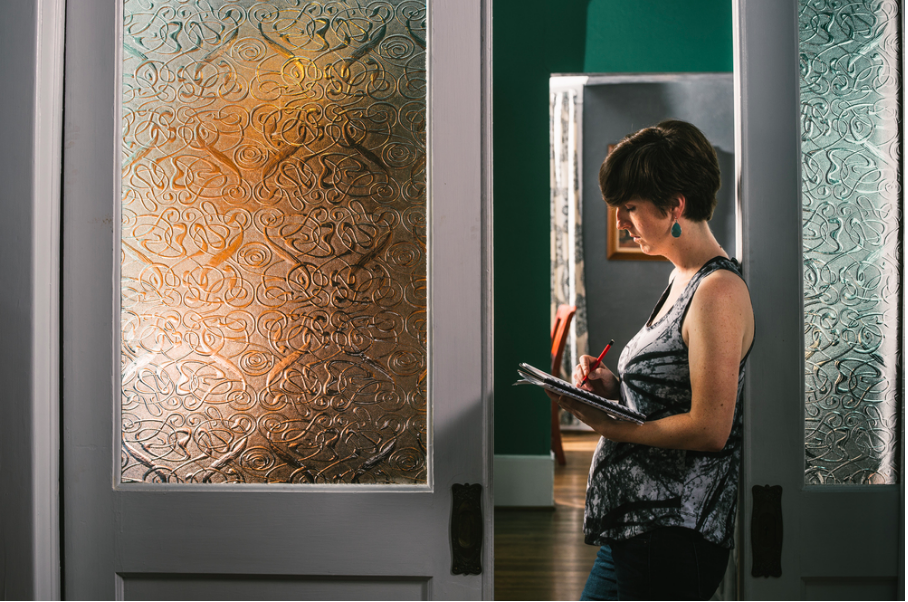MARGARET BARRETT
THE LANGUAGE OF HOME
Discovering Truth and Beauty Beyond Words
By Suzanne O’Dell
“Music expresses that which cannot be said and on which it is impossible to be silent.”
― Victor Hugo
The silhouette of a figure can be seen perched at attention before the keys of a sleek black piano, unmoving. Before a sound is heard, she nods her head reassuringly, then summons a series notes—robust yet slightly mournful-- from beneath poised fingertips. Her dangling earrings dance in time as she urges the music forward, the reverberations rising emphatically off the walls of the old house in a lone, swelling anthem. Below, the golden foot peddles move up and down with a familiar ease under feet belonging to Margaret Barrett, one of Dallas’ only female composers and a leading advocate for the city’s burgeoning music scene. Effervescent in personality and style, the unpretentious nose-ring wearing artist is an unlikely character to cast in a long line of white-wigged musical prodigies. Even she admits candidly that by all logic and appearances, she shouldn’t be where she is today—creating music that has defined art, performance, film and the like for audiences nationwide. A self-described “unwilling” casualty of her musical calling, Margaret’s journey as an artist has always been about moving out of isolation and into community, naming the unnamed, and embracing the abstract nature of her craft to unearth something named, something familiar, something called “home”.
Situated on a residential street lined with mature trees, the Barrett’s house serves as a postage stamp of nostalgia in a culturally vibrant East Dallas neighborhood teetering on the cusp of resurrected prominence. The exterior is adorned in harbor blue with white trim—a joyfully simple but eclectic nod to a Scandinavian home by the sea. Wooden steps lead up to the extended arms of a wide and spacious front porch strung with yellow lights and arrangement of barn-red sitting furniture.
The charming prairie house is cleverly named “Stravinsky, “after the famous Russian composer whose orchestral masterpiece “The Rite of Spring” was conceived in 1912, the same year the property was built.
Meanwhile, Zelda, the Barrett’s adolescent Boston terrier, basks in the arrival of our strange company, leaping from person to person with unbridled enthusiasm—nearly to the point of anxiety--her big beautiful eyes flickering with, as Margaret describes, “ a bad case of ‘FOMO’,” the perpetual “fear of missing out” on something new or exciting.
Margaret is, by nature, the perfect extension of Stravinsky’s openness and warmth. She is generous with her laughter, her gestures, and her poignant expressions of fascination, surprise, and intrigue—even at this early hour of the morning. She’s one of those people with the rare ability to gently usher the frivolities of small talk into the arms of an honest conversation with a natural and seamless grace that seems borderline super-natural.
Even as she flies around the kitchen preparing tea and coffee, she uses her whole body to talk. The wide, sweeping motions of her arms dwarf her slender frame, which, at a close second glance, is budding ever so slightly with evidence of her first child, due to arrive in September.
But for the twenty-something composer, there was a time when finding common ground—both in the language of music and relationships--wasn’t nearly as effortless.
During her teenage years, Margaret’s family relocated to Germany in the middle of a debilitating family crisis.
“Moving overseas and living around no English speakers while learning a new language and culture isolated our family into itself,” she stops to remember. “The problems my parents were having were no longer a backdrop, but the forefront of our daily lives.”
During this time, she attended German school, yet was unable to speak a word to her peers. Without an outlet to communicate her grief and frustration surrounding the turmoil of her family life, Margaret drew into herself, a place that soon became increasingly claustrophobic and lonely.
It was not until she began taking piano lessons that the deafening silence broke. Unlike her fellow classmates, Margaret wasn’t merely interested in memorizing scales and chords, she was regularly writing and playing her own music . . . a providential discovery that would soon became her liberation.
“Its so awesome that something as simple as a series of organized vibrations can move and shift something inside of humans and change the way we feel, think, and interact with our world—how is that possible?”
Even though the language of music had opened up a new portal of possibilities, Margaret’s movement into the composing world was full of doubt and apprehension.
“I was just looking for a good excuse to give it all up,” she recalls. “Up until then, my musical language was petty basic—I could only judge myself with how catchy a piece sounded.”
One day, her composition instructor, Dr. Scott McAllister—who Margaret credits as hugely essential in the development of her her musical career—gave her some contemporary composers to listen to, challenging her to develop her compositional palate beyond the conventional to where she had ever ventured before.
“I put on a CD by a composer named Steve Reich. I opened the score, pressed play on the track, and sat stunned for the entire 12 minutes of the piece.”
“I remember thinking, where have these sounds been all my life? All my life I’ve been living without music like this. It feels like I’ve come home. This is home.”
This sense of “home”—of closeness, of being known, understood, and embraced—has since been Margaret’s enduring inspiration and pursuit behind each of her musical endeavors.
When I create a piece of music, I want someone in the audience to be listening and for something inside them to nod, to say, ‘Yes. This piece confirms something. This piece of music is pointing me to something I have always known and felt and desired and yet haven’t named.’
This cathartic final effect doesn’t come without toil and struggle. The nature of Margaret’s craft itself is, at first, anything resembling the safety and comfort of home. It’s isolating, chaotic, abstract, depressing, and terribly exhausting.
“Unlike a visual artists, who can paint a blue swatch and that blue swatch stays there for them to observe in its actual form and tweak it to be a different form, my “swatches” are all imagined,” she explains.
“Everything I do in the creative stage so abstract. This is what tortures and depresses me sometimes about my craft, but yet, I still do it! I don’t know why, but I haven’t stopped yet . . . I’ll let that be sign enough.”
This ability to reach out into the unknown, into the gray space of relationships and life--is where we find the humble brilliance of Margaret Barrett the artist.
She possesses the uncanny resilience required to wade through currents of sounds to highlight and unify individual notes, much like she does with the people around her. Honest concerning her struggle, she remains a visionary of the unseen, an unlikely disciple of artistic grace, the self-proclaimed imperfect translator of the mysterious and sometimes cryptic music that surrounds her.
I’m often flying blind at the beginning, feeling like I’m starting from scratch, like I’m in Kindergarten again. I’m unsure. I know nothing of what I’m doing. I’m an imposter making this up as I go along. I have to make the choice: Will I quit? Or, will I take the leap of faith and create?
After a day spent talking, laughing, and entertaining a now satisfied but exhausted Zelda, we we finally ask Margaret what she hopes to do with her music. She pauses uncharacteristically for a moment before responding, but it’s not because she doesn’t know.
If there’s anything we’ve learned about Margaret, it is that after searching for the “why” for so long, she can never truly separate it from her life or her work:
I want my music to remind people to keep searching, to remind them of the beauty of eternity, of love, of a kind and pursuing God that is real . . . to keep seeking. I want people to know that what they crave of beauty and truth exists and not to give up on that. I think art--and particularly music--has the power to do this in a way that nothing else can.
That night we leave Stravinsky understanding something that perhaps we’ve always sensed but never known before: that like the promises of companionship and belonging draw us into the open doors of home, the truth and beauty of good music is able to communicate the same enduring story to the human soul: that we are known, we are seen, and despite—and even in the midst of-- the bleak and silent spaces of gray . . . we are never truly alone.

